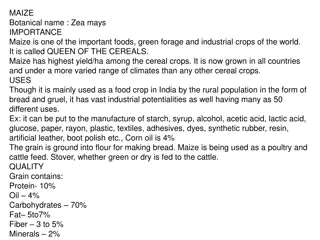Trailblazing Maize Cytogeneticist: Barbara McClintock's Revolutionary Discoveries
Barbara McClintock, a pioneering geneticist, revolutionized the field of maize cytogenetics through her groundbreaking discoveries on genetic recombination, transposition, and gene expression. Her innovative techniques and concepts reshaped our understanding of chromosomes and gene regulation, leading to her remarkable achievements and prestigious recognition, including the Nobel Prize in Physiology or Medicine in 1983.
Download Presentation

Please find below an Image/Link to download the presentation.
The content on the website is provided AS IS for your information and personal use only. It may not be sold, licensed, or shared on other websites without obtaining consent from the author.If you encounter any issues during the download, it is possible that the publisher has removed the file from their server.
You are allowed to download the files provided on this website for personal or commercial use, subject to the condition that they are used lawfully. All files are the property of their respective owners.
The content on the website is provided AS IS for your information and personal use only. It may not be sold, licensed, or shared on other websites without obtaining consent from the author.
E N D
Presentation Transcript
Suman Upadhyay Graduate student in Biology, Memorial University
PhD in botany from Cornell University in 1927 Leader in the development of maize cytogenetics She developed the technique for visualizing maize chromosomes and used microscopic analysis to demonstrate many fundamental genetic ideas. She was recognized among the best in the field, awarded prestigious fellowships. Member of National Academy of sciences and presided the Genetics society of America. Awards and recognition for her contributions to the field followed, including the Nobel Prize in Physiology or Medicine, awarded to her in 1983 for the discovery of genetic transposition; she is the only woman to receive an unshared Nobel Prize in that category.
One of those ideas was the notion of genetic recombination by crossing-over during meiosis a mechanism by which chromosomes exchange information. She produced the first genetic map for maize, linking regions of the chromosome to physical traits. She demonstrated the role of the telomere and centromere, regions of the chromosome that are important in the conservation of genetic information She made an extensive study of the cytogenetics and ethnobotany of maize races from South America
Studies of the origin and expression of gene instability at a number of known loci in the maize chromosomes were summarized by 1951-52 studies by Barbara McClintock . It was concluded that changes in genie expression result from chromosome alterations at the locus of a gene and these are initiated by units other than those composing the gene itself. These mutations are therefore considered as chromosomal modifications effecting gene expressions Each exerts a specific type of control of the action of the gene with which it becomes associated. These units may be transposed from one location to another within the chromosome complement. When incorporated at a new location, each expresses its mode of control of the action of the associated gene, and in a manner similar to that which occurred at the former location. Called Dissociation Activator ( Ds-AC) two-unit system
Transpositions of Ds or AC, or both, may occur in a few gametic cells. Consequently, a few gametes ma)- be formed with Ds or Ac or both, located at new positions. Following such transposition, each remains at the new location until, in a subsequent cell or plant generation, transposition to another location again occurs
Dicentric chromatid formation deficiency, Duplication of segments, Inversions, Ring-chromosomes and Reciprocal translocations between chromosomes. In all of these cases, the chromosome breaks are produced as the consequence of some initial change involving the Ds unit
When Ds is transposed to the locus of a known gene, it may immediately- or subsequently affect its action. This is expressed either by partial or complete inhibition, or by a previously unrecognized type of altered gene expression. As long as Ds remains in this position, gene action is subject to further change. It has been possible to determine that the subsequent changes are reflections of alterations occurring at the locus, and these are initiated by Ds. No Ds-initiated changes will occur, however, unless Ac is also present in the nucleus. If Ac is absent, no further modification of gene action occurs. The mutation present at the time of removal of A will be stable in expression in subsequent generations until Ac is again introduced into a zygote. In some cells of the plant arising from this zygote, alterations at the locus of the gene, initiated by Ds, again will occur.
Some of these may result in further modifications of gene action-that is, new mutations. Both the initial mutation and subsequent mutations are expressions, therefore, of interaction between Ds and AC. Thus, these two chromosomal units comprise a nuclear system capable of controlling gene expression ; Ds initiates changes in gene expression and .--Ac controls when they will occur
Some abbreviations Sh2- normal development of endosperm Some abbreviations Sh1- shrunken endosperm, located a quarter of a crossover unit distal to A1. Bm1- colourless secondary cell walls in plant tissues bm1-brown mid-rib, brown colour in secondary cell walls; A1 locus of chromosome 3.a1 is associated with Ac elements Culture 6424 is a particular culture of previously crossed plants
AC is responsible for producing breaks at Ds, wherever it may be located, and for controlling mutability at known locus with specific functions
Ds elements may transpose from one part to another by transposase enzyme. Viruses discovered later use transposition to infect mammalian cells.eg: HPV which causes Cervical Cancer In reverse genetics transposition can be used to study functions of genomes. Most elements in mammalian genes are transposable elements
McClintock, Barbara. "Induction of instability at selected loci in maize."Genetics 38.6 (1953): 579. https://en.wikipedia.org/wiki/Barbara_McClin tock http://library.cshl.edu/personal- collections/barbara-mcclintock























